
Improving economy offsets structural drag on office demand: Investa
Changing work patterns, including the wider embrace of flexible working, will eat into the take-up of CBD office by between 5 and 10 per cent in coming years, according to property platform Investa.
But the forecast – it balances out a reduced need for workplaces due to working from home against increased used of office space for team building and collaboration – is nevertheless a significantly rosier one than Investa delivered at the end of 2020, when the negative net take-up of space was estimated to be between 10 and 15 per cent.
In effect, Investa has softened its expectations for a negative net absorption of office space in the major capitals, including Sydney and Melbourne, due to a structural change in work patterns. Net absorption is an industry metric that measures the change in occupied office space over a period.
David Cannington, Investa’s head of research, said the improved forecast was in response to a series of brighter signals in the market, including the progressive return of workers to city offices along with improving business conditions.
“There is still a significant degree of uncertainty around how businesses are expected to respond and how they are expecting to use their workplace and offices when they return,” he told The Australian Financial Review.
Stronger rates of office occupancy in Brisbane, Adelaide and Perth showed there was more take-up of space to come in Sydney and especially Melbourne, he said.
“We have also been watching the sublease vacancy,” he said. “More recently, we’ve seen data, and across our own portfolio, where tenants are withdrawing space they had put up for sublease. We are seeing some early signs of tenants taking up sublease vacancy as well.
“It is not an exact calculation but all of those things indicate that net negative impact will be less than what we thought it might have been at the end of 2020.”
In Investa’s estimates, increased workplace flexibility and remote work are expected to soften underlying demand for office space, but that tendency is offset by the greater utilisation of the office workplace for collaboration, team-based work, meetings and innovation.
However, beyond the impact of such structural change, the greatest influence on office demand is the economic cycle itself, which drives white-collar employment and ultimately capital city office space absorption. Job creation and business expansion is expected to continue to account for about 60-65 per cent of Australian CBD gross absorption, according to Investa.
However Citi analysts are taking a less sanguine view on office demand and remain negative on landlords with passive office exposures.
“While physical occupancy has improved from its lows during the onset of COVID, it continues to be lower than pre-COVID occupancy estimates, even in cities with less government restrictions/COVID impacts,” Citi analysts wrote this week.
“We see this as a sign of shifting preferences towards more flexible working. We believe this is likely to lead to longer-term space reductions by tenants, with adverse impacts to office rents and asset values.”











